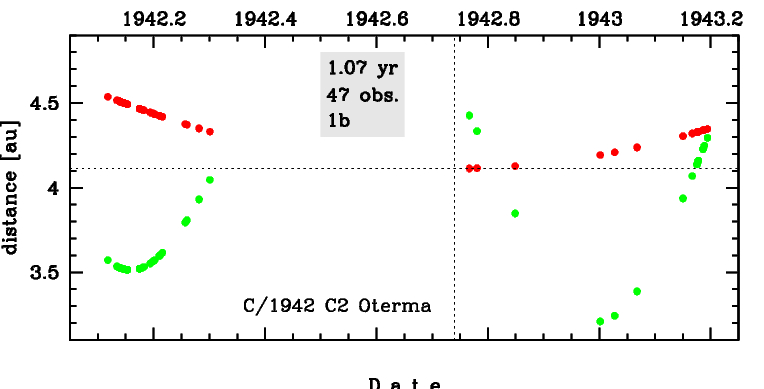C/1942 C2 Oterma
more info
Comet C/1942 C2 was discovered on 12 February 1942, about 7.5 months before perihelion passage and was last seen on 9 March 1943 [Kronk, Cometography: Volume 4].
This comet made its closest approach to the Earth on 29 December 1942 (3.21 au), that is three months after perihelion passage.
Solution given here is based on data spanning over 1.07 yr in a range of heliocentric distances from 4.53 au through perihelion (4.11 au) to 4.35 au.
Pure gravitational orbit determined from all available positional measurements (47 observations) give slightly hyperbolic original barycentric orbit (1b-class orbit); also original orbit given in Minor Planet Center is hyperbolic (35 obs. used, 2-days shorter arc of data; 1B-class orbit, see MPC).
This Oort spike comet suffers small planetary perturbations during its passage through the planetary system that lead to escape the comet from the solar system on a hyperbolic orbit (see future barycentric orbit).
More details in Królikowska et al. 2014 andKrólikowska and Dybczyński 2017.
This comet made its closest approach to the Earth on 29 December 1942 (3.21 au), that is three months after perihelion passage.
Solution given here is based on data spanning over 1.07 yr in a range of heliocentric distances from 4.53 au through perihelion (4.11 au) to 4.35 au.
Pure gravitational orbit determined from all available positional measurements (47 observations) give slightly hyperbolic original barycentric orbit (1b-class orbit); also original orbit given in Minor Planet Center is hyperbolic (35 obs. used, 2-days shorter arc of data; 1B-class orbit, see MPC).
This Oort spike comet suffers small planetary perturbations during its passage through the planetary system that lead to escape the comet from the solar system on a hyperbolic orbit (see future barycentric orbit).
More details in Królikowska et al. 2014 andKrólikowska and Dybczyński 2017.
| solution description | ||
|---|---|---|
| number of observations | 47 | |
| data interval | 1942 02 12 – 1943 03 11 | |
| data type | perihelion within the observation arc (FULL) | |
| data arc selection | entire data set (STD) | |
| range of heliocentric distances | 4.53 au – 4.11 au (perihelion) – 4.35 au | |
| detectability of NG effects in the comet's motion | NG effects not determinable | |
| type of model of motion | GR - gravitational orbit | |
| data weighting | YES | |
| number of residuals | 88 | |
| RMS [arcseconds] | 1.57 | |
| orbit quality class | 1b | |
| orbital elements (heliocentric ecliptic J2000) | ||
|---|---|---|
| Epoch | 1942 10 08 | |
| perihelion date | 1942 09 27.28002500 | ± 0.00770300 |
| perihelion distance [au] | 4.11339144 | ± 0.00003196 |
| eccentricity | 1.00316671 | ± 0.00005609 |
| argument of perihelion [°] | 163.620216 | ± 0.001441 |
| ascending node [°] | 281.038570 | ± 0.000853 |
| inclination [°] | 172.514474 | ± 0.000124 |
| reciprocal semi-major axis [10-6 au-1] | -769.85 | ± 13.62 |
